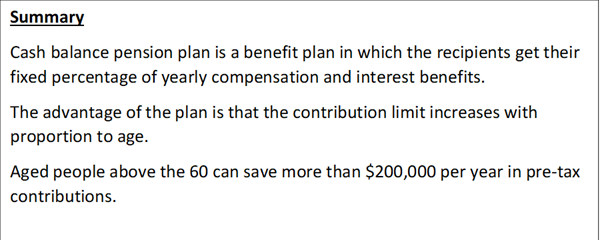Definition
Related Definitions
Cash Balance Pension Plan
What do you mean by Cash Balance Pension Plan?
A cash balance benefit plan is a pension plan with a choice for a lifetime annuity. For a cash balance benefit plan, the employer acknowledges a member's record for a set level of their yearly pay in addition to interest charges.
A cash balance benefit plan is a defined benefit plan. Accordingly, the arrangement's financing limits, subsidising prerequisites, and risk depend on characterised advantage necessities. Changes in the portfolio don't influence the last advantages of the member upon retirement or end. The organisation bears all responsibility for all gains and losses in the portfolio.

Understanding Cash Balance Pension Plan
As we know that a cash balance benefit plan is a defined-benefit plan; in contrast to the defined-benefit program, the cash balance benefit plan is kept upon an individual record premise, similar to a contribution plan. The cash balance benefit plan acts comparably to a defined contribution plan since changes in the worth of the member's portfolio don't influence the yearly contribution.
The additional highlights of a cash balance benefit plan look like those of 401(k) plans. As in a customary annuity plan, ventures are overseen expertly, and members are guaranteed a specific advantage at retirement. Nonetheless, the benefits are expressed as far as a 401(k)- style account balance instead of the conditions of a month-to-month revenue stream.
A cash balance benefit plan with a 401(k) can help a retirement saver slice their expense bills and support their savings. In any case, the individuals who rely upon liberal conventional annuity plans are less energetic.
At retirement, a cash balance benefit plan offers representatives (and their bosses) a decision. They can take the cash that has been set to the side for them in a precise amount or settle on a regularly scheduled installment dependent on the equilibrium. The regularly scheduled installment depends on the service term of the employee and the most significant three back-to-back long periods of compensation as well as individual life expectancy.
Numerous more seasoned entrepreneurs search out these kinds of plans to turbocharge their retirement reserve funds in light of the liberal commitment that restricts that increment with age. Individuals 60 years and more established can store above and beyond US $200,000 every year in pre-tax duties.
The significant part, particularly for more seasoned laborers, is that the admissible sums that can be kept are limitless. The breaking point is set on the most significant fair payout. For 2021, the cut-off for a benefits payout is US $230,000 every year. Working back from that point, an aged proficient could place in near US $300,000 every year.
The 401(k), all-out manager, and representative commitments for those 50 and more seasoned are significantly more restricted. For the 2021 duty year, the most extreme consolidated commitment is US $64,500 ($63,500 for 2020). That figure incorporates a US $6,500 "make up for lost time" stipend for those matured 50 and over.
Cash balance employer contributions for average workers ordinarily sum to generally 6% of pay contrasted and the 3% commitments that are commonplace of 401(k) plans. Participants additionally get a yearly "premium credit". For example, this credit might be set at a fixed rate, for example, 5%, or a variable rate, for example, the 30-year Treasury rate. At retirement, members can take an annuity dependent on their fund balance, or a precise amount, which would then be moved into an IRA or another business plan.
Cash balance benefit plans can be more exorbitant to managers than 401(k) plans, to some extent because a statistician should affirm every year that the arrangement is appropriately financed. Common expenses incorporate US $2,000 to US $5,000 in arrangement charges, US $2,000 to US $10,000 in yearly organisation expenses, and portfolio management charges going from 0.25% to 1% of resources.
Frequently Asked Questions
- What are the pros and cons of a Cash Balance Pension Plan?
- A cash balance benefit plan offers a guaranteed benefit for the beneficiaries. Each retiree will ultimately receive their due be it in a lump-sum manner or an annuity. This is why many people prefer this over a 401(k), where the payout is determined majorly based on performance.
- A cash balance benefit plan has many incentives which help in the retention of employees in an organisation. These plans offer flexibility to the retirees, which means they can transfer or rollover their projects to a different retirement plan according to their needs.
- It is easier to understand for an individual as it eliminates the complex conditions generally observed in regular pension plans.
- Cash balance benefit plans also proved flexible for the employers as the contribution can be varied accordingly. There are no strict limits for contributions.
- Cash balance benefit plans are usually cost-efficient because it very likely the individuals receive a lump-sum payout. Once the lump-sum payout is initiated, the employer does not require adhering to any responsibility here on in contrast to the traditional benefit plans.
The cons of a cash balance benefit plan are as follows:
- The employer has to make all the defined payments irrespective of what the economic conditions are in contrast to the 401(k) plan where the employees usually contribute.
- All the investment risk of the portfolio in a cash balance benefit plan is to be borne by the employer. In other plans, such as the 401(k), the participants decide their own risk and return.
- The cash balance benefit plan is less beneficial for individuals who have been working for a long time with the organisation or are older. This is because the cash balance benefits plan rewards consistently throughout the term of an employee. Traditional plans tend to take into consideration the later years and the high-earning years of an individual.
